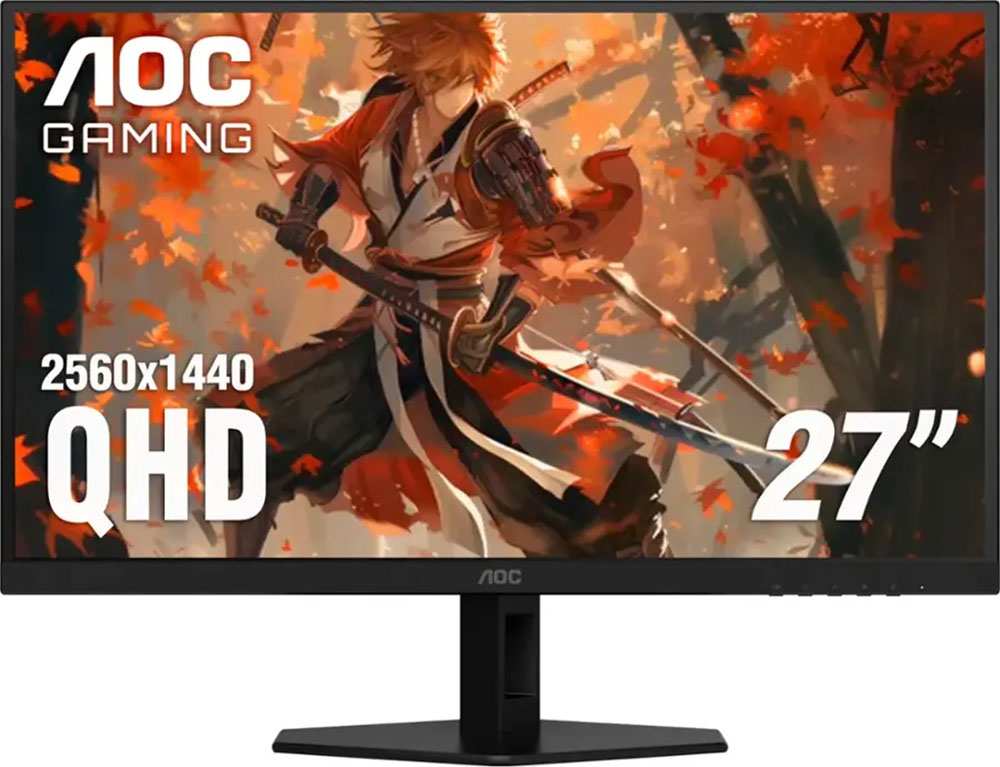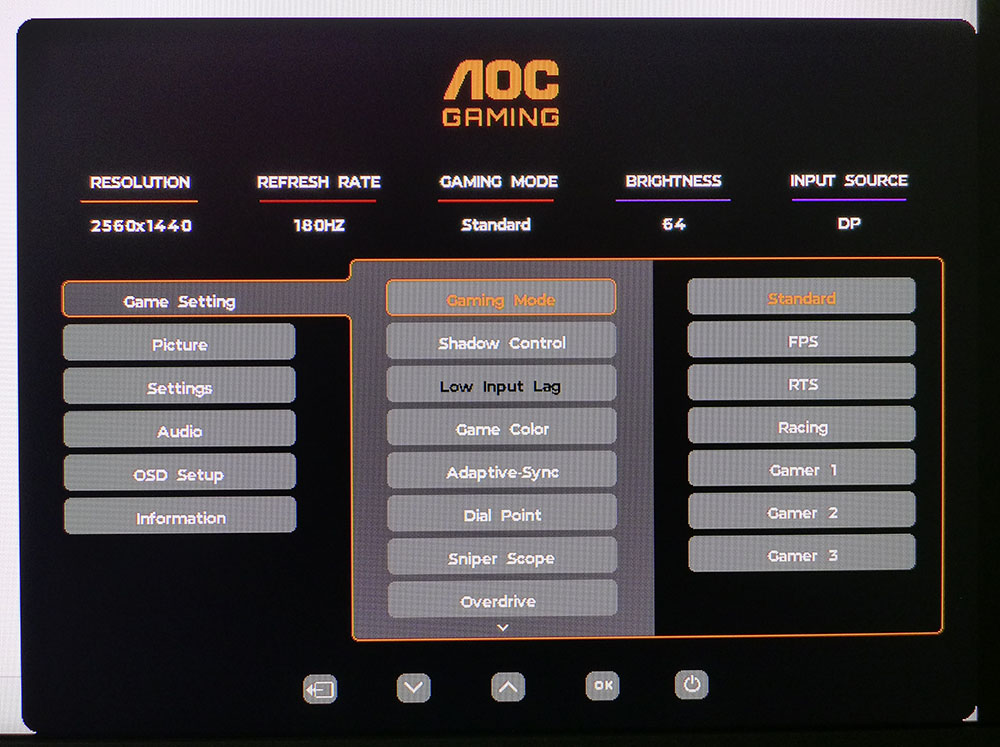Tom’s Hardware Verdict
The AOC Q27G40XMN delivers high brightness and saturated color with smooth and responsive gaming for a super competitive price. It’s one of the best all-around Mini LED monitors in the value segment.
Pros
- +
One of the brightest and most contrasty LCDs you can buy
- +
Very colorful with accurate color for HDR
- +
Local dimming increases dynamic range for SDR and HDR
- +
Excellent video processing
Cons
- –
SDR color is pleasing but not strictly accurate
- –
No speakers or USB ports
- –
Minimalist stand
Why you can trust Tom’s Hardware Our expert reviewers spend hours testing and comparing products and services so you can choose the best for you. Find out more about how we test.
With all the positive vibes coming from the OLED monitor camp, you might assume that it solves every problem and renders all other technology irrelevant. This is particularly true in areas such as contrast and video processing. But one thing OLEDs are not is super bright. If you want high output, I’m talking 1,000 nits or more, the solution is Mini LED. These panels have hundreds, and in some cases thousands, of individual LEDs arranged behind the TFT layer.
Better still, this technology is also less expensive than what’s found in the best OLED gaming monitors. When coupled with local dimming, where screen zones can be modulated independently, the contrast ratio is significantly higher than that of LCD monitors with edge array backlights.
I’m looking at AOC’s newest example here, the Q27G40XMN. This panel combines a QHD 2560×1440 resolution with VA technology and a full array local dimming (FALD) backlight featuring 1,152 zones, HDR1000, a wide gamut Quantum Dot film, 180 Hz, Adaptive-Sync, and a price point under $300. Let’s take a look.
AOC Q27G40XMN Specs
Swipe to scroll horizontally
|
Panel Type / Backlight |
VA / Mini LED |
| Row 1 – Cell 0 |
1,152 dimming zones |
|
Screen Size / Aspect Ratio |
27 inches / 16:9 |
|
Max Resolution and Refresh Rate |
2560×1440 @ 180 Hz |
| Row 4 – Cell 0 |
FreeSync and G-Sync Compatible |
|
Native Color Depth and Gamut |
10-bit (8-bit+FRC) / DCI-P3+ |
| Row 6 – Cell 0 |
HDR10, DisplayHDR 1000 |
|
Response Time (GTG) |
1ms |
|
Brightness (mfr) |
450 nits |
|
Contrast (mfr) |
5,000:1 |
|
Speakers |
None |
|
Video Inputs |
1x DisplayPort 1.4 |
| Row 12 – Cell 0 |
1x HDMI 2.0 |
|
Audio |
3.5mm headphone output |
|
USB |
None |
|
Power Consumption |
27.5w, brightness @ 200 nits |
|
Panel Dimensions WxHxD w/base |
24.2 x 18.2 x 5.9 inches (615 x 462 x 150mm) |
|
Panel Thickness |
2.3 inches (58mm) |
|
Bezel Width |
Top/sides: 0.3 inch (8mm) |
| Row 19 – Cell 0 |
Bottom: 0.8 inch (20mm) |
|
Weight |
14 pounds (6.35kg) |
|
Warranty |
3 years |
Mini LED was a premium technology until recently, when prices took a significant downturn. The Q27G40XMN is currently selling for $270, which is a great deal considering a monitor like this would have easily cost $500 two years ago.
For that sum, you get a 27-inch QHD 2560×1440 resolution panel with VA tech. The combination of VA and zone dimming results in extremely high contrast. Natively, the panel delivers a contrast ratio of around 4,800:1, which gives it more than four times the dynamic range of an IPS monitor. Engaging the 1,152-zone local dimming feature ups the range to almost 34,000:1, and you can go all the way to infinite at the most aggressive setting. At that point, black levels become too low to measure because the backlight is turned off.
Also present here is a Quantum Dot film for extra color coverage. The Q27G40XMN fills the DCI-P3 gamut to over 104%, making the image very colorful for both SDR and HDR content. HDR is further enhanced by tremendous light output. The certification is DisplayHDR1000, but I measured 1,357 nits peak in my tests.
Although the Q27G40XMN doesn’t have the perfect motion resolution of a premium OLED panel, AOC has included a superb overdrive that maximizes the 180 Hz maximum refresh rate and Adaptive-Sync. I observed very smooth processing in both test patterns and real-world gameplay, which could almost fool one into thinking the frame rate is even faster. I also noted that the input lag is low enough to be competition-worthy.
For those who need a little help with aim-and-shoot, there are reticles, including a dynamic option, three sniper scopes, and shadow control, to help bring out details in dark places. Image tweakers will find multiple picture modes, adjustable gamma, color temperature presets, and a super-accurate sRGB mode suited for creative applications. HDR comes with four modes of its own.
Physically, the Q27G40XMN saves on cost with a basic stand, no LEDs, internal speakers, or USB ports. But like any good value-oriented display, it has everything you need and nothing you don’t. And it’s less than $300 out the door.
Assembly and Accessories
AOC has made the switch to recyclable packaging with the Q27G40XMN securely packed in molded pulp. The three component pieces assemble without tools into a solid package. The power supply is internal, so you get an IEC cord along with DisplayPort and HDMI cables.
Product 360

The stand is a minimalist affair that attaches at the bottom of the panel. This approach allows for 5/23 degrees tilt only. There is no height or swivel adjustment. The stand’s low fulcrum means the panel’s top moves away from you when tilting, so positioning takes a bit more effort. The picture is nice and sharp, with bright colors and no visible grain from the anti-glare layer, which does its job effectively.
The bezel is just 8mm around the top and sides, with a flush mount that disappears when the picture is off. The bottom trim has a screened-on AOC logo and a tiny power LED. In the photo, you can just see five control keys protruding from the bottom right. There’s no joystick here, sadly, but the buttons get the job done.
In the back are two nods to the Q27G40XMN’s purpose: a logo that says, “AOC Gaming,” and a red ring. There are no LEDs, but the ring hides a secret. You might be looking at the picture and wondering where the 100mm VESA mount is. At the bottom of the ring is a tiny slot that, when pried open with a fingernail, releases a round panel, revealing the mount along with four fasteners. The remainder of the back side is finished in angled bits with soft corners, no sharp edges here. That shape continues onto the stand with a slick offset cable hole that sits so you don’t see through it from the front.
The input panel has just three ports, HDMI 2.0, DisplayPort 1.4, and a 3.5mm headphone jack. There are no internal speakers or USB ports.
OSD Features
The Q27G40XMN’s OSD will appeal to Star Trek fans; it reminds me of the control panels on the bridge of the Enterprise D. Rather than scanning for life forms, it presents the settings in five logically arranged sub-menus. It appears when you press the second key from the right.

The OSD starts with Game Setting and the seven picture modes. The only one you’ll need is Standard, and conveniently, it’s the default. The rest of the menu features gaming aids, including Shadow Control to brighten dark areas, Dial Point, which offers both static and dynamic aiming points, Sniper Scope with three magnifications, and a superb four-level overdrive. Faster is the best setting to eliminate almost all motion blur with no ghosting artifacts. The aiming point can also be set to remain in contrast with the background by changing color automatically.
In the Picture menu, you’ll find five gamma presets and four color temps. The User slot features RGB sliders that enabled me to achieve a very accurate point with grayscale. However, I encountered gamma issues that required some compromise; more on that later. The three HDR modes pictured can be used as emulations for SDR content, providing a subtle change that some users will appreciate. When actual HDR signals are present, a fourth slot appears, labeled “Display.” I found some luminance tracking problems there that sent me back to HDR Game as the go-to choice for all HDR content.
Local Dimming comes in three levels and significantly increases contrast by lowering black levels. The Strong setting turns the backlight off completely, resulting in an unmeasurable dynamic range. It can be used for both SDR and HDR content. Also in this menu are color space options that include sRGB and DCI-P3. The former choice is spot-on and well-suited for creative applications.
AOC Q27G40XMN Calibration Settings
Initial measurements of the Q27G40XMN showed a need for calibration, but I encountered a few head-scratchers along the way. Grayscale tends to run a bit blue, so you’ll want to adjust that. However, switching to the User color temperature skews the gamma. In either case, the color gamut is vast with bonus saturation in all six colors. After comparing modes, I settled on the calibration with skewed gamma as the best-looking image. Try my settings below to see what your preference is. If you need sRGB, that mode is right on the reference with no tweaking required. For HDR, I recommend the default HDR Game mode. It’s the most accurate with the highest light output.
Swipe to scroll horizontally
|
Picture Mode |
Standard |
|
Brightness 200 nits |
64 |
|
Brightness 120 nits |
32 |
|
Brightness 100 nits |
25 |
|
Brightness 80 nits |
16 |
|
Brightness 50 nits |
5 (min. 39 nits) |
|
Contrast |
47 |
|
Gamma |
2.4 |
|
Color Temp User |
Red 55, Green 55, Blue 45 |
Gaming and Hands-on
Full disclosure: I’m spoiled by OLED gaming monitors. But comparing the $270 Q27G40XMN to one of those simply wouldn’t be fair. But I will anyway.
If price is no object, OLED is the easy choice. But if you’re on a budget, you won’t be sad to play games on the Q27G40XMN. Booting up Doom Eternal, you’ll see a bunch of intro screens, which are the first clue that it’s really good at HDR. Color is bold and saturated, and the highlights leap from the screen. The left-right pan you see while Horde Mode is loading shows the Space Marine in a vivid green hue that you won’t see on non-Quantum Dot monitors. Even though the resolution is QHD, high contrast makes the picture sharper.
Getting into the maps, the action is smooth and fast. At 180fps, the GeForce RTX 4090 poses no problem, so I set the overdrive to Fastest and fragged away. Input lag was no higher than any premium gaming screen, so I had equal adeptness with quick turns and circle strafe maneuvers. Motion was free of artifacts, but I could see just the tiniest hint of blur. This is where my spoiled-by-OLED sensibilities kick in. Make no mistake, the Q27G40XMN looks and games amazingly well.
In daily use, the Q27G40XMN is a very competent display for things like Word and Excel. Web browsing and basic graphics work are a pleasure, but slight color inaccuracies were noticeable during critical tasks in Photoshop. It’s not that it can’t do these things well, it’s that I’m used to color that is perfectly on spec. The Q27G40XMN isn’t quite there, but its color is very pleasing, and there’s plenty of it. If you gravitate towards the most colorful screens, you’ll be attracted to it for sure.
Physical interaction left me wishing for a higher stand. I didn’t miss the swivel adjustment, but I do prefer the screen to be vertical with my eyepoint centered. A low fulcrum stand like this doesn’t allow that, so I had to tilt the screen up. This is forgivable considering the Q27G40XMN’s price point. I also noted the lack of USB ports and speakers, but this is a common omission for the segment.
Takeaway: The Q27G40XMN is an excellent gaming monitor with precise overdrive for next to no motion blur and low input lag. It’s one of the least expensive monitors I’ve seen that qualifies for competition. It also delivers very saturated color and incredibly high contrast. That local dimming is available for SDR and HDR is a bonus. And it works well for everyday tasks and casual entertainment.
MORE: Best Gaming Monitors
MORE: How We Test PC Monitors
MORE: How to Buy a PC Monitor

